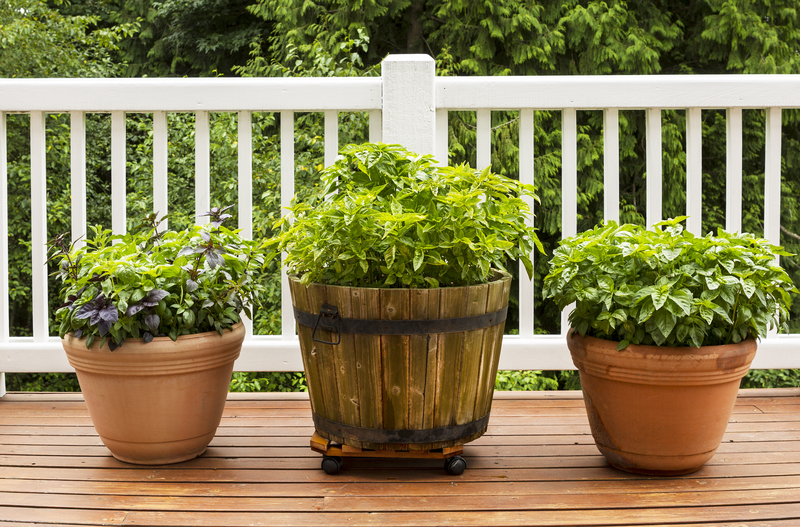Achieve Stunning Garden Designs with Hedge Trimming
Posted on 13/09/2025
Achieve Stunning Garden Designs with Hedge Trimming
Garden design is an art that combines nature and creativity, transforming any outdoor space into a lush, inviting haven. Among the essential elements in landscaping, hedge trimming stands out as a powerful technique to shape, define, and beautify your garden. Whether you are aiming for formal elegance or a relaxed, naturalistic look, mastering hedge trimming is a surefire way to achieve stunning garden designs that captivate all who visit.
Why Hedge Trimming is Crucial for Beautiful Gardens
Hedges contribute structure, privacy, and visual interest to gardens of all sizes. Through regular hedge maintenance, homeowners can foster healthier plants, establish captivating lines, and frame garden features. Below, we explore the core reasons why hedge trimming is fundamental for sensational garden designs:
- Defining Garden Spaces: Well-shaped hedges act as living walls, helping to establish purposeful areas within your garden.
- Enhancing Visual Appeal: Trimmed hedges display clean lines and crisp edges, elevating the aesthetics of any landscape.
- Encouraging Plant Health: Removing overgrown or dead wood improves air circulation and light penetration, promoting vigorous growth.
- Providing Privacy and Screening: Dense, sculpted hedges serve as natural barriers that offer seclusion and protection from wind and noise.
- Supporting Biodiversity: Diverse hedge types provide shelter and food for birds, insects, and other wildlife.

Different Styles of Garden Hedges
Your choice of hedge style will shape your garden's overall mood and functionality. Consider the following popular designs for inspiring possibilities:
Formal Hedges for Classic Gardens
Formal gardens often feature meticulously trimmed hedges with symmetrical shapes and sharp corners. Think of the iconic English or French parterre gardens. Techniques such as box shaping or *topiary* (sculpting hedges into artistic figures) create a sense of order and grandeur.
- Perfect for geometric layouts and well-defined borders
- Common plant choices: Buxus (Boxwood), Yew, Privet, Hornbeam
Informal Hedges for Naturalistic Settings
For a looser, more relaxed ambiance, informal hedges allow shrubs to grow with minimal intervention, trimmed only lightly to maintain their natural shape. This approach fits cottage, wildlife, and woodland gardens.
- Supports pollinators and local fauna
- Typical species: Laurel, Hawthorn, Viburnum, Escallonia
Mixed and Flowering Hedges
Mingle different shrub varieties in a single hedge for seasonal color and texture. Flowering species add fragrance and attract beneficial insects, enhancing the sensory appeal of your garden.
- Offers year-round interest with blooms, berries, and foliage
- Suggestions: Forsythia, Pyracantha, Rose, Lavender
Best Tools for Effective Hedge Trimming
Achieving crisp, healthy hedges depends significantly on your choice of equipment. Here are the essential hedge trimming tools for gardeners:
- Hand Shears: Best for precise cuts on smaller, softer branches and for detail work on topiary.
- Hedge Trimmers: Available as manual, electric, or petrol-powered models; optimal for tackling extensive hedges efficiently.
- Loppers: Great for thick branches that standard trimmers can't handle.
- Secateurs: Essential for snipping individual stems and cleaning up missed shoots.
- Safety Gear: Gloves, safety goggles, and ear protection help safeguard your health while working.
How to Trim Hedges for Stunning Garden Designs
Plan Your Hedge Shape
Before diving in, visualize the finished look. For straight or geometric hedges, use string lines and stakes to mark boundaries. For curves or undulating forms, outline the desired shape with a hose or spray paint on the ground for guidance.
When to Trim Different Hedge Types
- Evergreen Hedges: Best trimmed in late spring or early summer, after the risk of frost has subsided and new growth starts.
- Deciduous Hedges: Late winter or early spring (before leaf buds burst) is ideal for formative pruning.
- Flowering Hedges: Trim immediately after flowering to prevent cutting off next season's buds.
Step-by-Step Hedge Trimming Techniques
- Start at the Bottom: Always work from the base up to avoid piling trimmings onto areas you have not yet reached.
- Maintain a Tapered Shape: The base should be wider than the top, ensuring that lower branches receive enough sunlight.
- Trim in Stages: Remove no more than one-third of the growth at a time to avoid stress and encourage denser growth.
- Check for Level and Symmetry: Step back periodically to assess your work and make adjustments as needed.
- Clean Up Well: Collect and compost trimmings, and inspect for pests or diseases as you go.
Common Mistakes to Avoid in Hedge Maintenance
Even the most enthusiastic gardener can make errors. Here are pitfalls to watch out for when managing your garden hedges:
- Over-Pruning: Cutting back too harshly can damage the plant, especially evergreens, which may not regrow from old wood.
- Lack of Regular Maintenance: Neglecting trimming results in unruly, sparse hedges that are harder to restore.
- Ignoring Hedge Health: Failure to inspect and treat for pests, diseases, or nutrient deficiencies can lead to dieback and poor shape.
- Using Dull Tools: Blunt blades cause ragged cuts and increase the risk of infection.
Creative Hedge Trimming Ideas for Beautiful Landscapes
Take your garden styling to the next level with these imaginative approaches:
- Topiary Art: Sculpt whimsical shapes, animals, or geometric forms for a dramatic focal point.
- Mazes and Labyrinths: Use tall, closely trimmed hedges to design engaging garden pathways.
- Layered Planting: Combine hedges of varying heights, colors, and textures for depth and richness.
- Living Arches and Screens: Shape archways or privacy screens to frame vistas or shield unsightly views.
- Blooming Borders: Interplant flowering shrubs among evergreens for dynamic seasonal displays.
Incorporating Hedges with Garden Features
Hedges can complement patios, gazebos, ponds, and sculptures. Use them to:
- Direct attention to a centerpiece or anchor point in the landscape
- Disguise functional areas (compost bins, rainwater tanks) with elegant green screens
- Frame entrances, walkways, or seating spots, imbuing the space with a sense of occasion
Best Plants for Successful Hedge Trimming
Success begins with the right plant selection. Here are top choices tailored to various climates and design goals:
Evergreen Hedges
- Buxus sempervirens (Boxwood): The classic low-maintenance hedge, perfect for formal designs.
- Taxus baccata (Yew): Exceptionally long-lived and dense; ideal for topiary.
- Prunus laurocerasus (Cherry Laurel): Vigorous growth and glossy leaves, suitable for privacy screens.
- Ligustrum (Privet): Fast-growing, easy to shape, and tolerant of most soils.
Deciduous Hedges
- Carpinus betulus (Hornbeam): Holds on to many leaves through winter; graceful in both formal and naturalistic settings.
- Fagus sylvatica (Beech): Offers beautiful coppery leaves in autumn and winter interest.
- Corylus avellana (Hazel): Valued for wildlife gardens and edible nuts.
Flowering and Mixed Hedges
- Crataegus monogyna (Hawthorn): Brilliant spring blossoms and wildlife support.
- Escallonia: Evergreen, with summer flower clusters in pink, red, or white.
- Rosa rugosa: Robust, thorny shrub with fragrant flowers and attractive hips.
- Forsythia: Explosive yellow blooms announce spring's arrival.
Seasonal Care Tips for Gorgeous Hedges
Even the most beautifully trimmed hedge needs year-round hedge maintenance for optimal health and appearance:
- Spring: Apply balanced fertilizer and mulch; check for signs of winter damage.
- Summer: Water newly established hedges in dry spells; keep up with light shaping as needed.
- Autumn: Clear fallen leaves from around the base to prevent fungal issues; inspect for pests.
- Winter: Prune deciduous types; monitor for snow and ice damage, gently brushing off heavy accumulations.
Hedge Trimming and Garden Sustainability
Sustainability is a key trend in modern gardening. With thoughtful hedge trimming, you can advance biodiversity and resource conservation:
- Choose native or wildlife-friendly plants to provide food and shelter for local creatures.
- Compost hedge clippings or use them as mulch to improve soil health.
- Adopt water-wise gardening practices, choosing drought-tolerant hedge species in arid regions.
- Avoid pruning during nesting season if birds use your hedges as nesting sites.

Frequently Asked Questions About Hedge Trimming in Garden Design
- How often should I trim my garden hedges?
- Frequency depends on growth rate and desired neatness, but many formal hedges benefit from 2-3 trims per year. Informal or slow-growing varieties may only need an annual touch-up.
- Which shape is best for healthy hedges?
- Tapered sides (broader at the base, narrower at the top) help sunlight reach all foliage, promoting dense, even growth.
- Can I revive an old, overgrown hedge?
- Usually, yes. Most hedges respond well to gradual rejuvenation pruning over several seasons. Always research your particular plant species to avoid stressing it too much at once.
Conclusion: Transform Your Outdoor Space with Expert Hedge Trimming
Achieving stunning garden designs with hedge trimming is within reach for every homeowner and outdoor enthusiast. By selecting the right plant varieties, maintaining regular care routines, and experimenting with creative shapes, you can unlock the full potential of your green spaces. Remember, healthy hedges not only define and beautify your garden but also create nurturing habitats for wildlife and contribute to a sustainable environment.
Start planning your hedge design project today and watch your garden stand out with elegance, order, and natural charm. With patience, the right tools, and a dash of creativity, your garden will flourish, making a lasting impression in every season.

